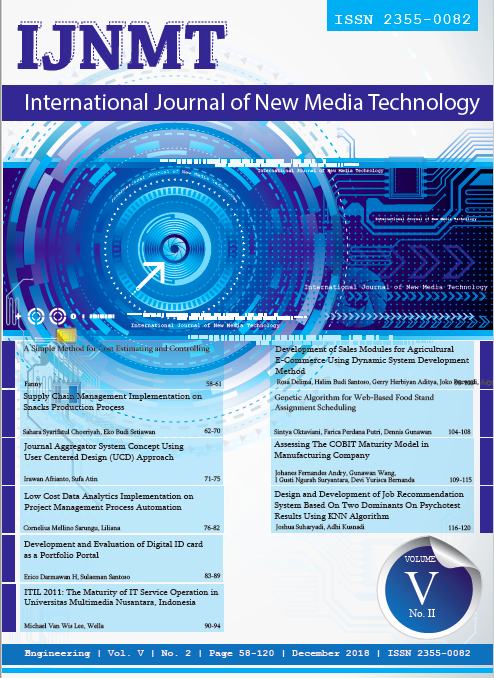Genetic Algorithm for Web-Based Food Stand Assignment Scheduling
DOI:
https://doi.org/10.31937/ijnmt.v5i2.926Abstract
Scheduling is a hard problem due to much considerations in many goals. Combination of goals in this scheduling cause the problem hard to solve even when using mathematical techniques. Optimization is a method which aim to achieve the best result with the least cost as possible. Optimization for large scale problem usually done with more modern technic, such as metaheuristic. Genetic Algorithm belongs to a larger system called Evolutionary Algorithm which is often used for solving the best value in optimization problem. Hence, this food stand assignment scheduling is build using Genetic Algorithm with population size of 50, uniform crossover with crossover rate of 0.25, mutation rate of 0.0125, and roulette wheel selection. An interview was conducted with three coordinators of fund and consumtion that results in three constraints used in building this system. Testing is done for three events and achieve mean fitness that is 87.967%, 89.609%, and 85.001% for FesTIval, TechnoFest, and DISCO, respectively.
Downloads
Downloads
Published
How to Cite
Issue
Section
License
Authors retain copyright and grant the journal right of first publication with the work simultaneously licensed under a Creative Commons Attribution-ShareAlike International License (CC-BY-SA 4.0) that allows others to share the work with an acknowledgement of the work's authorship and initial publication in this journal.
Authors are able to enter into separate, additional contractual arrangements for the non-exclusive distribution of the journal's published version of the work (e.g., post it to an institutional repository or publish it in a book), with an acknowledgement of its initial publication in this journal.
Copyright without Restrictions
The journal allows the author(s) to hold the copyright without restrictions and will retain publishing rights without restrictions.
The submitted papers are assumed to contain no proprietary material unprotected by patent or patent application; responsibility for technical content and for protection of proprietary material rests solely with the author(s) and their organizations and is not the responsibility of the IJNMT or its Editorial Staff. The main (first/corresponding) author is responsible for ensuring that the article has been seen and approved by all the other authors. It is the responsibility of the author to obtain all necessary copyright release permissions for the use of any copyrighted materials in the manuscript prior to the submission.















